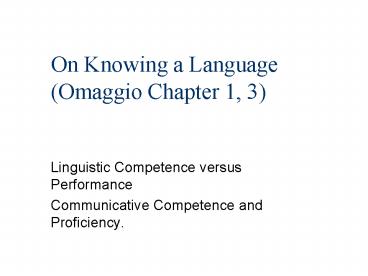On Knowing a Language Omaggio Chapter 1, 3 PowerPoint PPT Presentation
1 / 25
Title: On Knowing a Language Omaggio Chapter 1, 3
1
On Knowing a Language(Omaggio Chapter 1, 3)
- Linguistic Competence versus Performance
- Communicative Competence and Proficiency.
2
Linguistic Competence Versus Performance (Chomsky)
- Grammatical competence (Unconscious knowledge of
possible grammatical structures in an idealized
speaker) - What eats John?
- What does John eat?
- Performance (Actual production and comprehension
of language in specific instances of language
use) - Whe..When are you coming?
- I dont well uhm, maybe tomorrow.
3
Communicative Competence
- Hymes (1972)Knowledge of the appropriateness of
an utterance to a particular situation or context
and of its sociocultural significance. - Sauvignon (1972) the ability to function in a
truly communicative setting.
4
Redefining Language Competence
- Language Competence
- Organizational competence
- Grammatical Competence
- Textual Competence
- Pragmatic competence
- Illocutionary Competence
- Sociolinguistic Competence
5
The Notion of Proficiency
- Language competence develops through language
use. - Proficiency development of language competence
through language use. - Basic language use skills
- Speaking, listening, reading and writing
6
ACTFL Proficiency Guidelines
- Levels of proficiency
- Novice (No real functional ability to
communicate. Memorized words or phrases). - Low, Mid, High
- Intermediate (Can create with language, capable
of asking simple questions and answering them
with simple full sentences, can describe). - Low, Mid, High
7
ACTFL Proficiency Guidelines (2)
- Advanced (Can narrate and describe in major
time/aspect frames, can survive complicated
situations) - Low, Mid, High
- Superior (Can give supported opinions,
hypothesize, provide complicated explanations and
deal with abstract topics.
8
Assessment Criteria
- Global tasks/functions
- from naming objects or using basic greetings to
developing an argument - Context
- Settings in which language is used
9
Assessment Criteria
- Content
- Accuracy
- Text type
10
ACTFL Guidelines
- ACTFL Guidelines Speaking
11
Group Discussion
- Analyze the textbook and materials that you use
in class. What level of speaking proficiency do
you think your students are expected to attain at
the end of this semester? - Is it realistic?
12
Standards for Foreign Language Learning
- Communication
- Cultures
- Connections
- Comparisons
- Communities
13
Group Discussion
- Develop an activity that includes the following
Standards - 1.1. Students engage in conversation, provide and
obtain information, express feelings and emotions
and exchange opinions - 2.1. Students demonstrate the an understanding of
the relationship between the practices and
perspectives of the culture studied. - 5.1. Students use the language both within and
beyond the school setting.
14
On Teaching a Language
- A sobering fact
- The majority of bilinguals in the world acquire a
second language in naturalistic environments, not
in classroom settings. They acquire speaking and
listening skills and develop some form of
linguistic competence in the L2 through exposure
to a target language in language contact
situations.
15
On Teaching a Language(2)
- Rather than teaching a language we are
facilitators in the process of language
acquisition. - Our main role is to provide adequate input and a
positive environment for acquisition to take
place.
16
The Demands of Academic Settings
- In addition to facilitating the process of
language acquisition, in academic settings we are
expected to help the students acquire literacy
and cultural awareness.
17
Group Discussion
- Mention at least three cognitive skills needed
for the development of literacy that differ from
those needed for language acquisition (oral
skills, grammatical knowledge and lexicon).
18
How Do We Do It?
- Method
- Theoretical approach to language acquisition and
to literacy. - Teaching Strategies
- Syllabus/Frameworks.
19
Proficiency-oriented Method
- H 1
- Opportunities must be provided for students to
practice using language in a range of contexts
likely to be encountered in the target culture.
20
Proficiency-oriented Method
- Corollaries
- _ Express meaning as early as possible
- Active communicative interaction among students
- Creative language practice
- Authentic language
21
Proficiency-oriented Method
- H 2
- Opportunities should be provided for students
to practice carrying out a range of functions
(tasks) likely to be necessary in dealing with
others in the target culture.
22
Proficiency-oriented Method
- H 3
- The development of accuracy should be encouraged
in proficiency-oriented instruction. As learners
produce language, various forms of instruction
and evaluative feedback can be useful in
facilitating the progression of their skills
toward more precise and coherent language use.
23
Proficiency-oriented Method
- H4
- Instruction should be responsive to the
affective as well as the cognitive needs of the
students, and their different personalities,
preferences and learning styles should be taken
into account.
24
Proficiency-oriented Method
- H5
- Cultural understanding must be promoted in
various ways so that students are sensitive to
other cultures and are prepared to live more
harmoniously in the target culture.
25
Group Discussion
- How do the following methods differ from the
proficiency-oriented method? - Grammar-Translation Method
- Direct Method
- Audiolingual
- Total Physical Response
- Suggestopedia

